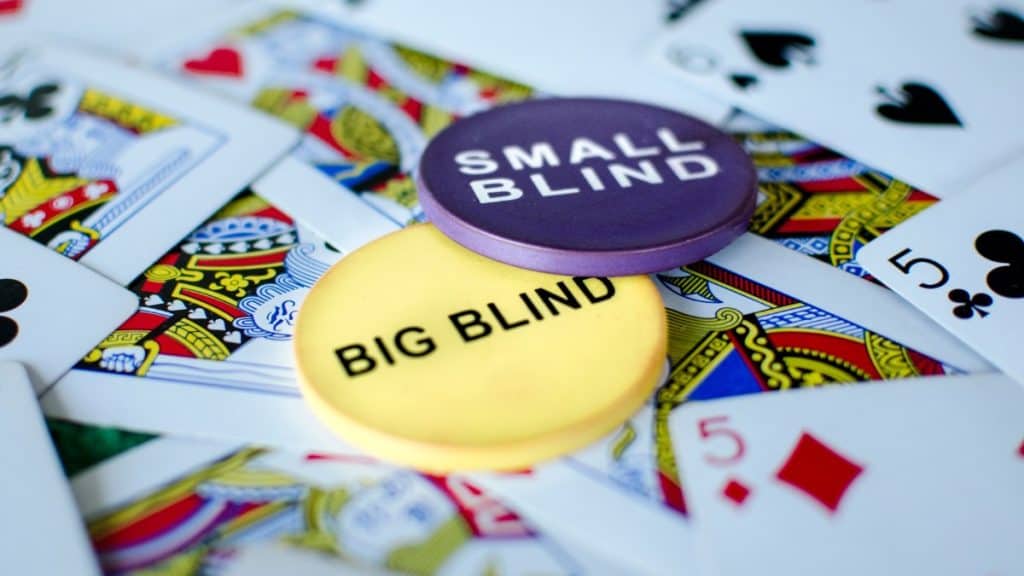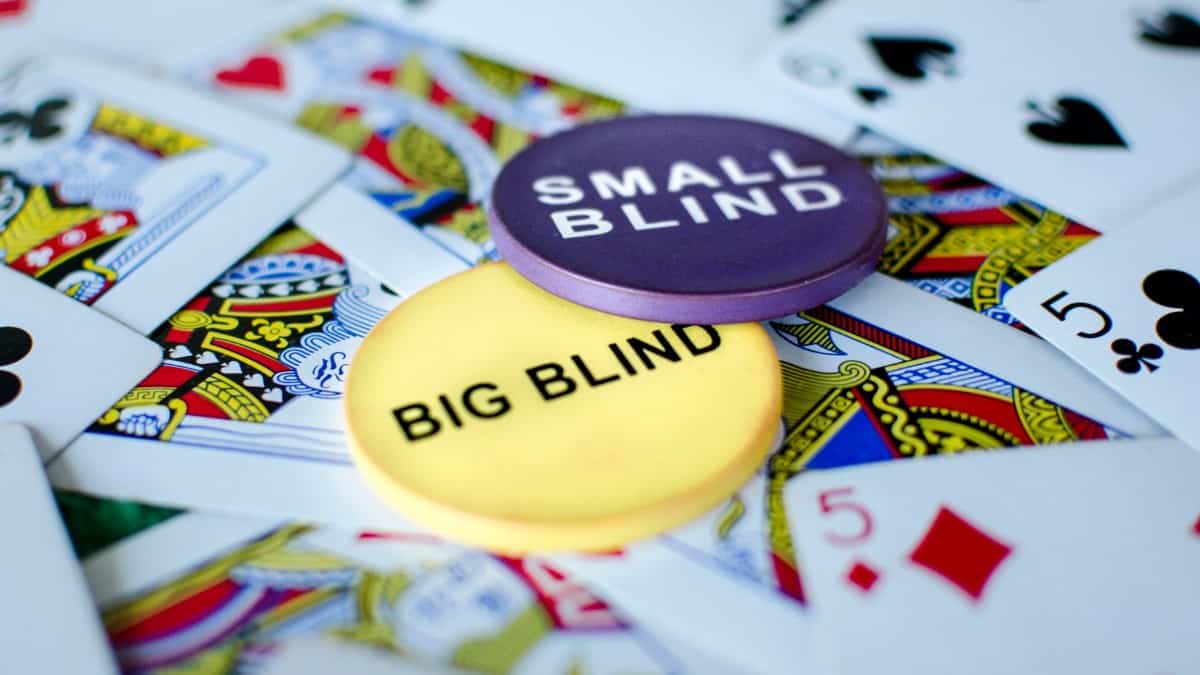
Big Blind vs. Small Blind: What’s the Difference in Poker?

The big blind/small blind structure isn’t just a formality: it’s the engine that keeps the game alive.
These two forced bets are what ensure there’s always something to fight for, and without them, every hand could turn into a staring contest of folded cards and wasted time.
But here’s the thing: while the small and big blinds are often lumped together, they couldn’t be more different in how they play and what they cost you.
Knowing when to fold, defend, or push back from either blind can be the difference between slowly leaking chips or holding your own at the table — and the better you understand their nuances, the sharper your edge becomes.
What Are the Small Blind and Big Blind?
At its core, poker is a game of decision-making under pressure. Blinds are how that pressure is guaranteed.
Two players, every hand, are required to put chips in the pot before seeing their cards: the small blind and the big blind. The small blind usually posts half the minimum bet, and the big blind posts the full amount.
But why force people to pay before they know what they’re holding?
Because if no one had to, poker would devolve into a waiting game. Everyone would fold until aces appeared. Blinds cut through that nonsense. They make every hand a little expensive, even if you plan to muck it.
As poker author Jonathan Little puts it: “Blinds create the incentive to play. Without them, there is no game, just a bunch of players passing time.”
Antes vs Blinds: Cousins, Not Twins
If blinds are a two-player tax at the best online poker sites, antes are the community jar.
In games like Seven-Card Stud or later-stage tournaments, everyone antes up before each hand; tiny amounts, sure, but multiplied across a table, it adds up fast.
Here’s the key difference: with blinds, you’re betting from a specific seat and gaining (or losing) positional advantages. With antes, you’re paying for entry no matter where you sit. It’s a slower burn, but it quietly builds pots and encourages action without relying on positional pressure.
Many modern tournament formats now use both antes and blinds, which is called the “big blind ante” system. It simplifies the math and speeds up the game, and most players agree it keeps the rhythm cleaner.
As of 2024, it’s standard in World Series of Poker events.
The Great Rotation: Everyone Pays Eventually
Poker isn’t about fairness (just ask anyone who’s been rivered by a two-outer). But the blind rotation? That part is fair.
After every hand, the dealer button moves one seat clockwise, and the blinds move with it.
This constant rotation means two things:
- Everyone gets their turn paying the price of admission
- No one can camp out in a comfy position forever.
If you’re under pressure now, someone else will be next.
And in tournaments? That pressure becomes a ticking clock. As blind levels rise every few minutes, that rotation goes from a fair mechanic to an existential threat.
The Invisible Weight on Every Decision
The blinds don’t just sit quietly on the table; they impact every decision. That late-position raise? Probably trying to steal your big blind. The limp from an early position? It could be someone trying to see the flop for cheap before the blinds hit them again.
As you play more, you start to feel them looming. Not just when you’re in them, but a few hands away. You start calculating your next three turns, not just your next move.
Blinds, in other words, are more than structure. They’re tense. And when you understand how they really function, you start playing poker, not just cards.
The Small Blind: Position and Implications
Ask any experienced poker player about the worst seat at the table, and most won’t hesitate: the small blind.
It might seem like a minor inconvenience, but this spot can be one of your biggest leaks if you’re not careful. You’re forced to put money into the pot, and you’re first to act post-flop, giving away the strategic upper hand from the start.
Statistically, it’s a losing position. Why? Because you’re in the hand with a partial investment, but you’re playing at a positional disadvantage. Fold too often, and you bleed chips; defend too much, and you end up in awkward, out-of-position pots.
The Big Blind: Role and Advantages
If the small blind is where chips quietly disappear, the big blind is where battles begin. It’s the position that demands a full bet before you’ve even peeked at your cards, which might sound unfair, until you realize that this seat, oddly enough, comes with more perks than problems.
Understanding the big blind in poker goes beyond just knowing the rulebook, it’s about recognizing how to turn a forced bet into a strategic weapon.
Unlike the small blind, which acts first post-flop and leaks value over time, the big blind gets to act last during the pre-flop betting round. That small delay makes a huge difference. It gives you a window into everyone else’s intentions — who’s raising, who’s limping, who’s folding — and lets you respond with a much clearer picture of the landscape.
And then there’s the math. Since you’ve already got a full bet in the pot, calling a raise often costs less relative to the size of the pot. That’s what gives the big blind such strong pot odds and makes it a more defensible position than its neighbor to the right.
In the big blind vs small blind debate, the big blind wins more hands, loses less money, and offers better leverage, even when you’re holding mediocre cards. That’s why seasoned players often defend this spot aggressively, especially against late-position opens that look suspiciously like steal attempts.
Still, it’s not a free pass. Post-flop, the big blind is usually out of position for the rest of the hand, which means you’re often making decisions before your opponents.
It’s not easy. But play it right, and it’s where grinders make their money.
Strategies for Playing the Small Blind
Let’s be honest, the small blind is not just a positional disadvantage; it’s a structural trap. You’ve already put chips in the pot, but you’re flying blind post-flop and acting first on every street.
So, what’s the strategy? Tighten up. Drastically. You’re better off folding hands from the small blind that you’d happily play from the button.
In the broader context of poker small blind big blind dynamics, your job here isn’t to win big pots, it’s to lose as little as possible.
Strategies for Playing the Big Blind
Unlike the small blind, where you’re trapped out of position with less invested, the big blind lets you see the action unfold before making your next move. You’ve already got one full bet in the pot, so you’re getting better pot odds to defend.
That’s why seasoned players don’t hesitate to defend the big blind with a wide range of hands, especially when the raise comes from the button or cutoff. Your odds often justify a call, or even a 3-bet.
The trick is to factor in who raised, from where, and how big. Against aggressive opponents with weak ranges, it can be profitable to fight back.
The beauty of the big blind is that it’s flexible. With the right reads, you can turn it into a profitable position over the long haul.
Small Blind vs Big Blind
When the action folds to the small blind, it sets up one of the most nuanced and aggressive spots in poker: small blind vs big blind heads-up.
This dynamic is high-stakes and high-frequency – two players, both out of position in different ways, battling over blinds with ultra-wide ranges.
The small blind, acting first pre- and post-flop, should open extremely wide—often up to 80–90% of hands in GTO solutions – using a mix of raises and limps depending on stack depth and opponent type.
Raising gives initiative but builds the pot out of position. Limping allows pot control but risks giving the big blind a cheap flop. Balance is key: raise premium hands and mix in weaker ones to avoid being predictable.
The big blind, closing the action, must defend aggressively. Facing a raise, players should re-raise (3-bet, a core move in poker betting basics) more often than usual, especially versus frequent stealers, and defend a wide range when calling.
Common pitfalls include playing too passively post-flop, c-betting too often from SB without equity, or over-folding BB to aggression. GTO strategies here are highly mixed, so population reads and adjusting to tendencies matter.
In all, understanding poker tells could be a huge benefit, but in general, just embrace the aggression. This spot prints chips for players who study it.
Differences Between Tournaments and Cash Games
In cash games, the small and big blind amounts stay the same for hours. You can play deep-stacked, pick your spots carefully, and grind it out. You can reload your chips anytime, which means you’re never truly at risk of elimination. It’s chess with cards and cash.
Tournaments, on the other hand, are a constant race against the blinds. Every few minutes, or levels, the blinds increase, and with them, the pressure.
Players can’t just sit back and wait for premium hands. You’re bleeding chips just by folding, so the strategy shifts: aggression becomes mandatory, and stealing blinds becomes essential.
This evolving structure forces adaptability. Knowing when and how to steal or defend blinds is one of the key factors that separates long-term winners in these games from the fish that feed them.
Blinds Aren’t Just Bets, They’re the Game
If you think the small and big blinds are just technicalities before the action starts, think again.
Playing them well means understanding the pressure they create, and the difference between bleeding chips and building stacks often starts in the blinds.
Mastering big blind vs small blind dynamics isn’t about memorizing charts or sticking to rigid rules. It’s about awareness. Who’s raising? How deep are the stacks? What stage is the game in? The players who ask — and answer — those questions with consistency are the ones who last.
Because in poker, the blinds don’t just cost you chips. They reveal your edge — or expose your leaks.